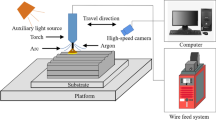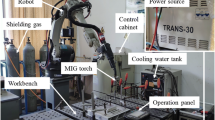Abstract
In the wire arc additive manufacturing (WAAM) process, the flow behavior of the molten pool determines the formation accuracy and formation defects. Therefore, it is significant to understand the complex physical process of the molten pool behavior in the WAAM. A real-time X-ray direct observation method and volume of fluid method (VOF) were performed to study the flow in molten pool and liquid flow in the molten pool. X-ray was used to observe the liquid flow in the molten pool and the droplet transfer from the WAAM. A three-dimensional model of the molten pool and droplet was established based on the VOF method, and the temperature distribution and flow status of the molten pool were calculated. By controlling different wire feeding speeds, two different droplet transfer modes were observed by X-ray, which include globular transfer and bridging transfer. Compared with globular transfer, bridging transition has little effect on molten pool flow. The flow model during the deposition process is established; the x–z plane is divided into four regions according to the flow characteristics of different positions in the molten pool. The maximum velocity in the molten pool appears in the action area of plasma arc force, which is 0.277 m/s, which leads to the increase in melting depth and promotes the flow of molten metal.













Similar content being viewed by others
Data availability
All authors promise that materials and data are authentic.
Code availability
Not applicable.
Abbreviations
- ρ :
-
Mass density
- t :
-
Time
- u :
-
X-velocity component
- v:
-
Y-velocity component
- w :
-
Z-velocity component
- \({m}_{s}\) :
-
Mass source term
- U s :
-
Thermal energy item
- p :
-
Pressure acting on fluid micro-element body
- p v :
-
External pressure acting on free surface
- P max :
-
Peak value of arc pressure
- \(\mu\) :
-
Viscosity
- F x :
-
X-component of volume force
- F y :
-
Y-component of volume force
- F z :
-
Z-component of volume force
- F drag :
-
Plasma flow force
- K :
-
Drag coefficient
- T :
-
Temperature
- \(\lambda\) :
-
Fluid thermal conductivity
- c :
-
Specific heat capacity of fluid
- η :
-
Heat efficiency
- η d :
-
Absorption rate of droplet
- rd :
-
Droplet radius
- rq :
-
Effective radius of arc
- T m :
-
Room temperature
- C p :
-
Specific heat capacity of droplet
- τ :
-
Droplet transfer frequency
- U:
-
Arc voltage
- \({\mu }_{m}\) :
-
Vacuum permeability
- H b :
-
Base metal thickness
- \({\sigma }_{j}\) :
-
Current density distribution parameters
- C ds :
-
Spherical drag coefficient
- \({\rho }_{g}\) :
-
Density of plasma gas
- \({D}_{d}\) :
-
Droplet diameter
- \({\nu }_{g}\) :
-
Velocity of plasma gas
- H W :
-
Arc length
- \({\mu }_{g}\) :
-
Plasma flow viscosity
- F s :
-
Local solid volume fraction
- F cr :
-
Critical solid volume fraction
- C0 :
-
Drag coefficient constant
- R:
-
Gas constant
- Q p :
-
Power output energy
- Q d :
-
Energy absorbed by droplets
- Q s :
-
Energy of welding wire separation
- Q w :
-
Energy entering molten pool
- Q dr :
-
Energy lost in droplets
- Q wr :
-
Energy lost in molten pool
- \(\varnothing\) :
-
Droplet transfer frequency
- I:
-
Arc current
- r :
-
Gaussian distribution radius
- σ :
-
Gauss heat distribution parameter
- \({\rho }_{p}\) :
-
Radius of Gaussian pressure
- \(\overrightarrow{n}\) :
-
Vector perpendicular to local free surface
- κ :
-
Free surface curvature
- γ :
-
The surface tension
References
Cunningham CR, Flynn JM, Shokrani A, Dhokia V, Newman ST (2018) Invited review article: strategies and processes for high quality wire arc additive manufacturing. Addit Manuf 22:672–686. https://doi.org/10.1016/j.addma.2018.06.020
Fan HG, Kovacevic R (1999) Droplet formation, detachment, and impingement on the molten pool in gas metal arc welding. Metall and Mater Trans B 30(4):791–801. https://doi.org/10.1007/s11663-999-0041-6
Wu B, Pan Z, Ding D et al (2018) A review of the wire arc additive manufacturing of metals: properties, defects and quality improvement. J Manuf Process 35:127–139. https://doi.org/10.1016/j.jmapro.2018.08.001
Luo Y, Li JL, Xu J, Zhu L, Han JT, Zhang CY (2018) Influence of pulsed arc on the metal droplet deposited by projected transfer mode in wire-arc additive manufacturing. J Mater Process Technol 259:353–360. https://doi.org/10.1016/j.jmatprotec.2018.04.047
Wu BT, Ding DH, Pan ZX, Cuiuri D, Li HJ, Han J et al (2017) Effects of heat accumulation on the arc characteristics and metal transfer behavior in Wire Arc Additive Manufacturing of Ti6Al4V. J Mater Process Technol 250:304–314. https://doi.org/10.1016/j.jmatprotec.2017.07.037
Ríos S, Colegrove PA, Williamsa SW (2019) Metal transfer modes in plasma Wire + Arc additive manufacture. J Mater Process Technol 264:45–54. https://doi.org/10.1016/j.jmatprotec.2018.08.043
Dutta P, Joshi Y, Janaswami R (1995) Thermal modelling of GTAW process with nonaxisymmetric boundary conditions. Heat Transfer A 27:499–518. https://doi.org/10.1080/10407789508913715
Zhao PC, Wu CS, Zhang YM (2004) Numerical simulation of the dynamic characteristics of weld pool geometry with step-changes of welding parameters. Modell Simul Mater Sci Eng 12(5):765. https://doi.org/10.1088/0965-0393/12/5/002
Mougenot J, Gonzalez JJ, Freton P et al (2013) Plasma-weld pool interaction in tungsten inert-gas configuration. J Phys D Appl Phys 46(13):135206–135220. https://doi.org/10.1088/0022-3727/46/13/135206
Kim CH, Zhang W, DebRoy T (2003) Modeling of temperature field and solidified surface profile during gas-metal arc welding. Journal of Physic: Apply Physic 94:2667–2679. https://doi.org/10.1063/1.1592012
Fan HG, Kovacevic R (1998) Dynamic analysis of globular metal transfer in gas metal arc welding- a comparison of numerical and experimental results. J Phys D Appl Phys 31(20):2929. https://doi.org/10.1088/0022-3727/31/20/029
Sun Y, Zhai L, Zhao M. Numerical simulation of weld pool geometry and surfaces deformation in GMAW. Transactions of the China Welding Institution, 2010, 10. https://doi.org/10.1155/2010/293410
Kumar S, Bhaduri SC (1995) Theoretical investigation of penetration characteristics in gas metal-arc welding using finite element method. Metall and Mater Trans B 26(3):611–624. https://doi.org/10.1007/BF02653882
Choi SK, Ko SH, Yoo CD et al (1998) Dynamic simulation of metal transfer in GMAW-part 2: short-circuit transer mode. Weld J 77:45-s. https://doi.org/10.1145/293701.293702
Bai X, Colegrove P, Ding J et al (2018) Numerical analysis of heat transfer and fluid flow in multilayer deposition of PAW-based wire and arc additive manufacturing. Int J Heat Mass Transf 124:504–516. https://doi.org/10.1016/j.ijheatmasstransfer.2018.03.085
Zhou X, Zhang H, Wang G et al (2016) Three-dimensional numerical simulation of arc and metal transport in arc welding based additive manufacturing. Int J Heat Mass Trans 103(dec.):521–537. https://doi.org/10.1016/j.ijheatmasstransfer.2016.06.084
Hejripour F, Valentine DT, Aidun DK (2018) Study of mass transport in cold wire deposition for Wire Arc Additive Manufacturing. Int J Heat Mass Transf 125:471–484. https://doi.org/10.1016/j.ijheatmasstransfer.2018.04.092
Hu Z, Hua L, Qin X et al (2021) Molten pool behaviors and forming appearance of robotic GMAW on complex surface with various welding positions. J Manuf Process 64:1359–1376. https://doi.org/10.1016/j.jmapro.2021.02.061
Zhao W, Wei Y, Long J, et al (2021) Modeling and simulation of heat transfer, fluid flow and geometry morphology in GMAW-based wire arc additive manufacturing. Welding in the World 1–20. https://doi.org/10.1007/s40194-021-01123-1
Ebrahimi A, Kleijn CR, Hermans MJM et al (2021) The effects of process parameters on melt-pool oscillatory behaviour in gas tungsten arc welding. J Phys D Appl Phys 54(27):275303. https://doi.org/10.1088/1361-6463/abf808/meta
Guimarães PB, Pedrosa PMA, Yadava YP et al (2011) Obtaining temperature fields as a function of efficiency in TIG welding by numerical modeling. Revista de Engenharia Térmica 10(1–2):50–54. https://doi.org/10.5380/reterm.v10i1-2.61952
Tong Z, Zheng Z, Rui Z (2013) A dynamic welding heat source model in pulsed current gas tungsten arc welding. J Mater Process Tech 213(12):2329–2338. https://doi.org/10.1016/j.jmatprotec.2013.07.007
Mirbagheri S, Dadashzadeh M, Serajzadeh S et al (2004) Modeling the effect of mould wall roughness on the melt flow simulation in casting process[J]. Appl Math Model 28(11):933–956. https://doi.org/10.1016/j.apm.2004.03.007
Zhou J, Tsai HL, Lehnhoff TF (2006) Investigation of transport phenomena and defect formation in pulsed laser keyhole welding of zinc-coated steels. J Phys D Appl Phys 39(24):5338. https://doi.org/10.1088/0022-3727/39/24/036
Ushio M, Wu CS (1997) Mathematical modeling of three-dimensional heat and fluid flow in a moving gas metal arc weld pool. Metal Mater Trans B 28(3):509–516. https://doi.org/10.1007/s11663-997-0118-z
Li K, Wu C (2009) Mechanism of Metal Transfer in DE-GMAW. J Mater Sci Technol 25(003):415–418. https://doi.org/10.3321/j.issn:1005-0302.2009.03.024
Schlichting H, Gersten K, Krause E, et al (1960) Boundary-layer theory. New York: cGraw-hill
Lee SY, Na SJ (1996) A numerical analysis of a stationary gas tungsten welding arc considering various electrode angles. Welding Journal-Including Welding Research Supplement 75(9):269s. https://doi.org/10.1016/1359-6462(96)00182-0
Kim YS, Eagar TW (1993) Analysis of metal transfer in gas metal arc welding. Welding Journal 72:269-s. https://doi.org/10.1088/0022-3727/36/9/313
Rhee S, Kannatey-Asibu E (1992) Observation of metal transfer during gas metal arc welding. Welding Journal 71:381-s
Sahoo P, DebRoy T, McNallan MJ (1988) Surface tension of binary metal—surface active solute systems under conditions relevant to welding metallurgy. Metall Trans B 19(3):483–491. https://doi.org/10.1007/BF02657748
Kothe DB, Mjolsness RC, Torrey MD (1991) RIPPLE: A computer program for incompressible flows with free surfaces. Available to DOE and DOE contractors from OSTI. https://doi.org/10.1063/1.4931086
Huang J, Yuan W, Yu S et al (2020) Droplet transfer behavior in bypass-coupled wire arc additive manufacturing. J Manuf Process 49:397–412. https://doi.org/10.1016/j.jmapro.2019.12.002
Funding
This work was financially supported by the National Natural Science Foundation of China (No. 5206050261).
Author information
Authors and Affiliations
Contributions
Jiankang Huang and Ding Fan proposed the research project, and conceived and designed the study and revised the manuscript; Zhuoxuan Li studied the welding process and wrote the manuscript; Shurong Yu improved the research by theory and revised the manuscript; Xiaoquan Yu corrected and modified the text and language.
Corresponding author
Ethics declarations
Consent to participate
All authors agree to participate and publish.
Competing interests
The authors declare no competing interests.
Additional information
Publisher's note
Springer Nature remains neutral with regard to jurisdictional claims in published maps and institutional affiliations.
Recommended for publication by Study Group 212—The Physics of Welding
Rights and permissions
About this article
Cite this article
Huang, J., Li, Z., Yu, S. et al. Real-time observation and numerical simulation of the molten pool flow and mass transfer behavior during wire arc additive manufacturing. Weld World 66, 481–494 (2022). https://doi.org/10.1007/s40194-021-01214-z
Received:
Accepted:
Published:
Issue Date:
DOI: https://doi.org/10.1007/s40194-021-01214-z




